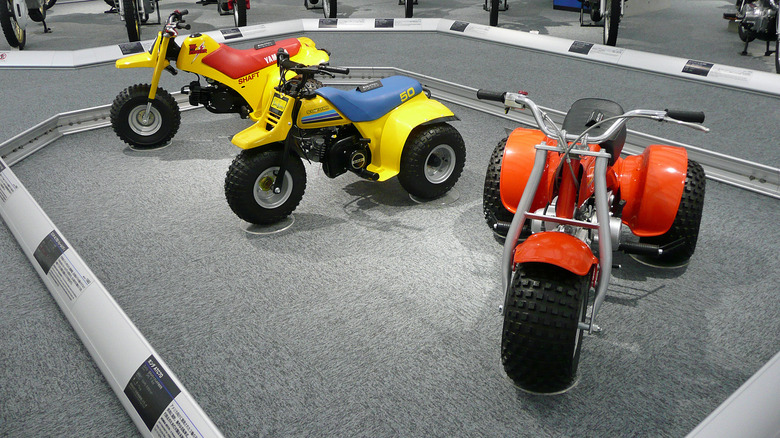The Real Reason America Banned The Honda ATC
It may be a foreign concept in today's world, but for many years vehicle safety was more of an afterthought than an actual policy. Seat belts weren't federally mandated for new cars until 1968. And states like New York, New Jersey, and California didn't make seat belt-wearing a law until the mid-1980s. In fact, New Hampshire still doesn't have a seat belt law.
Helmet laws for motorcycles were equally laissez-faire until 1967, when the government started making states create helmet laws if they wanted to receive federal highway safety funds. There's nothing like threatening to withhold money to get people motivated. By 1975, all but three states had helmet laws. A year later, Congress deemed it illegal to withhold funds, so states went back to a "do as you want" approach. According to the Governors Highway Safety Association (GHSA), only about half the states now require helmets for all riders. By contrast, the others only need it for riders under 18.
Believe it or not, the general public really didn't care about safety, and when the government got involved, it was considered an infringement on civil rights.
Around the same time frame, Honda's lead engineer, Osamu Takeuchi, first devised a three-wheeled all-terrain cycle (ATC) or all-terrain vehicle (ATV). The goal was to give Honda dealers something to sell during winter when margins were at their weakest. In 1970, Honda brought the $595 ATC 90 to market in the United States. This three-wheeled trike had a small footprint, was maneuverable, and easy to operate.
Get on your trike and ride!
At the low retail price of $595, the ATC was equipped with a 90cc four-stroke 7 horsepower engine, a four-speed transmission with an automatic clutch, and giant oversized balloon tires, which served a dual purpose. The sidewall flex of these bulbous tires created enough speed differential to turn so that it could operate with a solid rear axle. The low-pressure tires, meant to be inflated to only 2.2 PSI, absorbed any impact encountered on a trail. Thus, Honda avoided equipping them with an actual suspension system (via ATV Rider).
According to the Motorcyclist, sales of the vehicle averaged about 10,000 per year, and by 1978, approximately 150,000 had been sold. During that time, Honda discovered that rural areas had better sales than dealers in urban areas. As it turns out, farmers in those rural regions had found the ATV's utilitarian function was beneficial to their needs.
The ATV boom came during the 1980s, when several other manufacturers threw their proverbial all-terrain vehicles into the ring, including Yamaha, Suzuki, Kawasaki, and Polaris. The race was on, and suddenly these three-wheeled all-terrain cycles were everywhere. Print ads, TV commercials, and even movies, like the 1971 James Bond film "Diamonds are Forever," featured these quirky rides. Between their appearance and relatively low price, sales in urban areas surged.
But Honda wanted to draw in consumers who thought motorcycles were too dangerous, so they capitalized on the small dimensions, which unfortunately had made them just the right size for kids to drive. In fact, Honda made a 70cc version built explicitly for kids. And that's when the stubby little ATV ran into problems.
Kids were no match for this three wheeled monster
Aside from repeated issues with the rear axle breaking and a flawed footpeg design (via Motorcyclist), the three-wheeled ATV simply wasn't stable enough. Its small size and lack of suspension were "features" that relied on a rider's ability to transfer their weight to counterbalance the vehicle from flipping over (via CarScoops). Kids typically didn't weigh enough to pull off this counterbalance, so the rides were flipping over, leading to a dramatic rise in severe injuries and, in some cases, death.
A 1988 New York Times article states that ATVs were the cause of nearly 1,000 deaths and 300,000 injuries between 1983 and 1988, and a Time Magazine article from the same year said that almost 7,000 people a year were getting mauled by these metal monstrosities (via Hemmings).
ATV manufacturers naturally blamed the riders for irresponsible behavior, and part of that is likely true. Still, a study by the Consumer Product Safety Commission (CPSC) showed that the ATV's design caused "unpredictable rollovers during ordinary maneuvers." Additionally, its high center of gravity combined with a solid rear axle and lack of any suspension made turning... "tricky," according to the New York Times.
The U.S. Justice Department banned sales of three-wheeled ATVs that same year and manufacturers agreed to back a $100 million safety campaign. Additionally, they had to buy back all of the unsold ATVs that dealers had left in their inventory, Hemmings reported.

